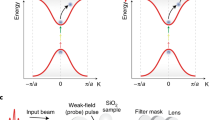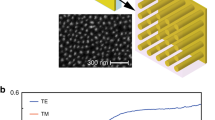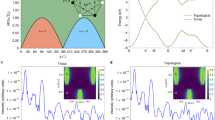Abstract
The high peak electric fields provided by single-cycle light pulses can be harnessed to manipulate and control charge motion in solid-state systems, resulting in electron emission out of metals and semiconductors1,2,3,4,5,6 or high harmonics generation in dielectrics7,8. These processes are of a non-perturbative character and require precise reproducibility of the electric-field profile9,10,11,12,13,14. Here, we vary the carrier-envelope phase of 6-fs-long near-infrared pulses with pJ-level energy to control electronic transport in a laterally confined nanoantenna with an 8 nm gap. Peak current densities of 50 MA cm–2 are achieved, corresponding to the transfer of individual electrons in a half-cycle period of 2 fs. The observed behaviours are made possible by the strong distortion of the effective tunnelling barrier due to the extreme electric fields that the nanostructure provides and sustains under sub-cycle optical biasing. Operating at room temperature and in a standard atmosphere, the performed experiments demonstrate a robust class of nanoelectronic switches gated by phase-locked optical transients of minute energy content.
This is a preview of subscription content, access via your institution
Access options
Subscribe to this journal
Receive 12 print issues and online access
$209.00 per year
only $17.42 per issue
Buy this article
- Purchase on Springer Link
- Instant access to full article PDF
Prices may be subject to local taxes which are calculated during checkout




Similar content being viewed by others
References
Herink, G., Solli, D. R., Gulde, M. & Ropers, C. Field-driven photoemission from nanostructures quenches the quiver motion. Nature 483, 190–193 (2012).
Schertz, F., Schmelzeisen, M., Kreiter, M., Elmers, H.-J. & Schönhense, G. Field emission of electrons generated by the near field of strongly coupled plasmons. Phys. Rev. Lett. 108, 237602 (2012).
Swanwick, M. E. et al. Nanostructured ultrafast silicon-tip optical field-emitter arrays. Nano Lett. 14, 5035–5043 (2014).
Wimmer, L. et al. Terahertz control of nanotip photoemission. Nat. Phys. 10, 432–436 (2014).
Herink, G., Wimmer, L. & Ropers, C. Field emission at terahertz frequencies AC-tunneling and ultrafast carrier dynamics. New J. Phys. 16, 123005 (2014).
Vogelsang, J. et al. Ultrafast electron emission from a sharp metal nanotaper driven by adiabatic nanofocusing of surface plasmons. Nano Lett. 15, 4685–4691 (2015).
Hohenleutner, M. et al. Real-time observation of interfering crystal electrons in high-harmonic generation. Nature 523, 572–575 (2015).
Luu, T. T. et al. Extreme ultraviolet high-harmonic spectroscopy of solids. Nature 521, 498–502 (2015).
Lemell, C., Tong, X.-M., Krausz, F. & Burgdörfer, J. Electron emission from metal surfaces by ultrashort pulses determination of the carrier-envelope phase. Phys. Rev. Lett. 90, 076403 (2003).
Dombi, P., Krausz, F. & Farkas, G. Ultrafast dynamics and carrier-envelope phase sensitivity of multiphoton photoemission from metal surfaces. J. Mod. Opt. 53, 163–172 (2006).
Krüger, M., Schenk, M. & Hommelhoff, P. Attosecond control of electrons emitted from a nanoscale metal tip. Nature 475, 78–81 (2011).
Schiffrin, A. et al. Optical-field-induced current in dielectrics. Nature 493, 70–74 (2012).
Piglosiewicz, B. et al. Carrier-envelope phase effects on the strong-field photoemission of electrons from metallic nanostructures. Nat. Photon. 8, 37–42 (2013).
Neppl, S. et al. Direct observation of electron propagation and dielectric screening on the atomic length scale. Nature 517, 342–346 (2015).
Paasch-Colberg, T. et al. Solid-state light-phase detector. Nat. Photon. 8, 214–218 (2014).
Cocker, T. L. et al. An ultrafast terahertz scanning tunnelling microscope. Nat. Photon. 7, 620–625 (2013).
Brida, D., Krauss, G., Sell, A. & Leitenstorfer, A. Ultrabroadband Er:fiber lasers. Laser Photon. Rev. 8, 409–428 (2014).
Krauss, G. et al. Synthesis of a single cycle of light with compact erbium-doped fibre technology. Nat. Photon. 4, 33–36 (2010).
Birge, J. R., Ell, R. & Kärtner, F. X. Two-dimensional spectral shearing interferometry for few-cycle pulse characterization. Opt. Lett. 31, 2063–2065 (2006).
Kakehata, M. et al. Single-shot measurement of carrier-envelope phase changes by spectral interferometry. Opt. Lett. 26, 1436–1438 (2001).
Kern, J. et al. Electrically driven optical antennas. Nat. Photon. 9, 582–586 (2015).
Mühlschlegel, P., Eisler, H.-J., Martin, O. J. F., Hecht, B. & Pohl, D. W. Resonant optical antennas. Science 308, 1607–1609 (2005).
Hohenester, U. & Trügler, A. MNPBEM—a Matlab toolbox for the simulation of plasmonic nanoparticles. Comput. Phys. Commun. 183, 370–381 (2012).
Hanke, T. et al. Tailoring spatiotemporal light confinement in single plasmonic nanoantennas. Nano Lett. 12, 992–996 (2012).
Fowler, R. H. & Nordheim, L. Electron emission in intense electric fields. Proc. R. Soc. Lond. A 119, 173–181 (1928).
Savage, K. et al. Revealing the quantum regime in tunnelling plasmonics. Nature 491, 574–577 (2012).
Esteban, R. et al. A classical treatment of optical tunneling in plasmonic gaps: extending the quantum corrected model to practical situations. Faraday Discuss. 178, 151–183 (2015).
Wan, Y., Wubs, M. & Mortensen, N. A. Projected dipole model for quantum plasmonics. Phys. Rev. Lett. 115, 137403 (2015).
Huber, R. et al. How many-particle interactions develop after ultrafast excitation of an electron–hole plasma. Nature 414, 286–289 (2001).
Acknowledgements
The authors acknowledge support from Deutsche Forschungsgemeinschaft through collaborative research centre SFB 767 and the Emmy Noether programme, from the European Research Council (Advanced Grant no. 290876), the Eliteprogramm of Baden-Württemberg Stiftung and the European Commission via the Marie Curie Carrier Integration Grant.
Author information
Authors and Affiliations
Contributions
A.L. and D.B. conceived the ideas and supervised the work. T.R., M.L. and M.F.S. built the laser system and fabricated the nanocircuits. V.K. numerically modelled the nanoantennas. T.R. and M.L. performed the tunnelling measurements. T.R., D.B. and A.L. wrote the manuscript. All authors contributed to the scientific discussions.
Corresponding authors
Ethics declarations
Competing interests
The authors declare no competing financial interests.
Rights and permissions
About this article
Cite this article
Rybka, T., Ludwig, M., Schmalz, M. et al. Sub-cycle optical phase control of nanotunnelling in the single-electron regime. Nature Photon 10, 667–670 (2016). https://doi.org/10.1038/nphoton.2016.174
Received:
Accepted:
Published:
Issue Date:
DOI: https://doi.org/10.1038/nphoton.2016.174
This article is cited by
-
Sub-cycle multidimensional spectroscopy of strongly correlated materials
Nature Photonics (2024)
-
Terahertz waveform synthesis in integrated thin-film lithium niobate platform
Nature Communications (2023)
-
Tracing attosecond electron emission from a nanometric metal tip
Nature (2023)
-
Few-femtosecond phase-sensitive detection of infrared electric fields with a third-order nonlinearity
Communications Physics (2023)
-
Attosecond field emission
Nature (2023)



